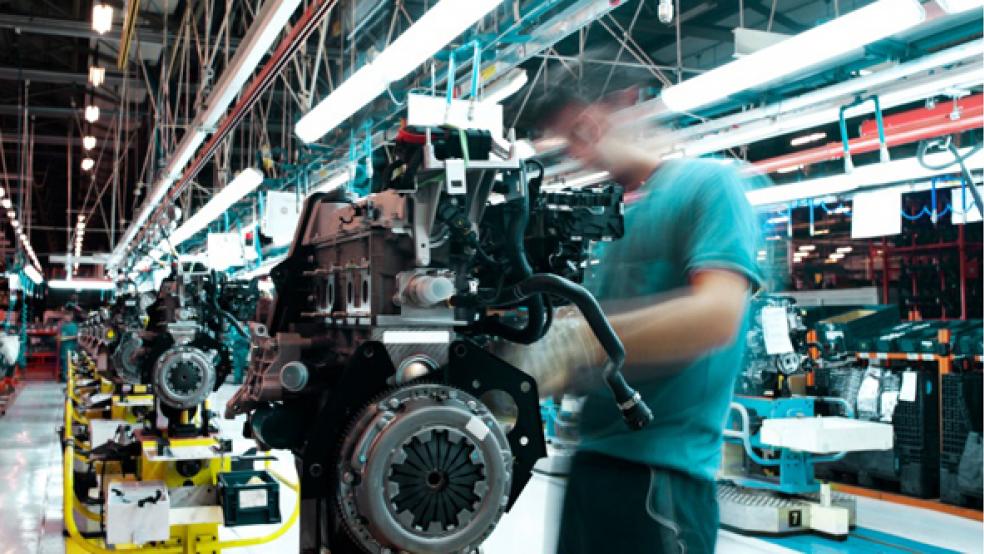Could manufacturing be the comeback kid in terms of job generation? That’s the way things look, relative to the growth of the overall economy.
Nationwide, manufacturers posted a 1.9 percent job increase in October 2010 and October 2011 compared to only a 1.1 percent increase in jobs overall in the economy during that same period, according to Bureau of Labor Statistics figures.
“Manufacturing is rebounding and playing a very real role in the recovery. We’re not seeing those sorts of job gains on the construction front or in most other sectors,” said James Diffley, managing director for U.S. Regional Services at IHS Global Insight. “But that goodness certainly isn’t being felt by everyone.”
One thing is clear: Even with the small overall spike in jobs within the manufacturing sector, there are definite regional winner and losers. State-specific product bases left some vulnerable to market shocks, while others in prime spots cashed in, economists say.
Manufacturers in Oklahoma, Utah, Louisiana, South Carolina and Michigan, for example, hiked their payrolls by more than 5 percent over the past year, with energy-rich Oklahoma leading the pack by adding a whopping 8.5 percent more positions in that field than a year ago.
However, companies in Arkanss, Oklahoma’s neighbor to the east slashed manufacturing jobs by 4 percent—a massive hit for a state where 13.1 percent of the workforce is in manufacturing. Only economies with much smaller manufacturing bases like Nevada, Montana and New Jersey experienced similar job loss percentages. But in Mississippi and Georgia, where manufacturing accounts for 12.1 percent and 9.1 percent of the economy, respectively, payrolls shrank too.
Oklahoma manufacturers capitalized on the state’s vast oil resources this year when higher worldwide oil prices prompted U.S. firms to add more domestic oil assets. The state’s active rig count grew from 142 in fall of 2010 to 197, according to oilfield services company Baker Hughes. As a result, hiring has spiked for the local manufacturers that provide oil companies with valves, sheet metal, pipes, and drilling tools.
Although oil and gas exploration has been a part of the Oklahoman economy since the 1920s, “Manufacturers have really emerged as the first in line to drive that extraction,” said Russell Evans, executive director of the Stephen C. Agee Economic Research and Policy Institute at Oklahoma City University. The economic resurgence has also led to retooling and upgrading of outdated infrastructure in many of the plants, according to Evans.
“For really the first time, many companies that support oil and gas are updating themselves. And just in time to take advantage of the oil prices and this upward pressure to produce fossil fuel until the U.S. finds an alternative,” he said.
The rebound in the auto industry has been the primary factor behind the 4.3 percent increase in manufacturing jobs in Michigan, which lost nearly 71,500 jobs in the state during 2008 and 2009, according to The Center for Automotive Research.
Motor vehicle parts manufacturing payrolls in Michigan grew from 88,900 in October. 2010 to 93,700 in October 2011, and auto plant assembly employment grew from 35,900 to 37,300 in that period, according to the Bureau of Labor Statistics. President Obama’s $80 billion auto industry bailout, which helped rescue automakers Chrysler Group and General Motors Co., contributed heavily to that growth, said Dan Meckstroth, chief economist at the Manufacturers’ Alliance/MAPI.
really tough on us
here. It’s driven up
the prices of corn and
soybean meal and now
we are really feeling it.”
“It’s not exactly like automobile manufacturing employment will ever be what it was, but there has been some rehiring and growth in jobs because the sector was so depressed during the recession,” he said.
But Arkansas is blessed with neither oil, gas nor automobiles. The state’s manufacturing payrolls dropped 4 percent in part because one of its dominant industries, poultry, is taking a beating as prices rise for chicken-feed--corn, wheat, and soybeans.
“Corn costs are the biggest financial burden on my business, and it’s made us cut back,” said Ed Fryar Jr., owner of Ozark Mountain Poultry, a chicken manufacturer in Rogers, Ark. In the fall of 2010, he employed roughly 650 workers, but now employs just 500. “Ethanol has been really tough on us here. It’s driven up the prices of corn and soybean meal and now we are really feeling it,” Fryar said. Other poultry manufacturers have felt the same pressure. Simmons Foods Inc. slashed 223 jobs at its Siloam Springs, Ark., plant in June to recoup costs for rising grain prices, and Petit Jean Poultry closed its Arkadelphia plant and laid off 400 workers.
However, Tyson Foods, the states’ and the country’s largest meat and poultry processor, has so far been able to keep its workforce. “Higher grain prices have affected our bottom line a bit, but we are lucky that we’ve been able to retain our workforce,” said Tonya Shaw, Tyson’s hiring manager for its Springdale, Ark. plant. Arkansas is the second-largest poultry producing state behind Georgia, which also experienced poultry manufacturing layoffs during the last year.
Adding to Arkansas’ plight are recent announcements that paper-maker Georgia Pacific would lay off as many as 700 workers at a sawmill and plywood plant in Crossett, and that home-appliance maker Whirlpool would lay off 1,000 workers when it closes a 55-year-old plant in Fort Smith that it intends to relocate to Mexico.





